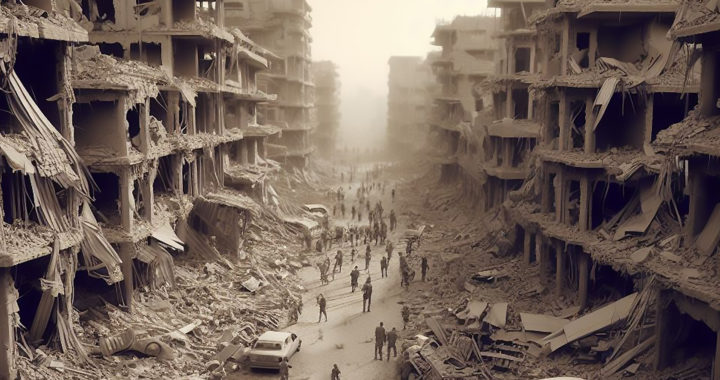The Israel-Hamas War is an armed conflict between the State of Israel and the Palestinian nationalist organization and a militant Sunni-Islamic fundamentalist movement Hamas. It started when Hamas militants launched an unprecedented cross-border attack into Israel from the Gaza Strip on the morning of 7 October 2023. At least 1400 Israeli residents and several non-Israeli nationals were massacred while some were taken hostage.
Israel carried out retaliatory strikes and declared war on Hamas on the same day. Governments condemned Hamas for its gruesome attacks while civilian groups around the world went to the streets in support of the longstanding plea to free Palestine from Israeli occupation. Take note that the armed conflict between the Israeli government and Hamas militants did not emerge overnight. It is part of the longstanding Israeli-Palestinian conflict.
Why Are Israel and Hamas at War: A Definitive Explainer on the Origin and Causes of the Israel-Hamas War
Background of the Conflict Between Israel and Palestine
Understanding the root cause of the Israel-Hamas War requires factoring in the longstanding conflict between Israel and Palestine. This broader conflict predates the establishment of the State of Israel in 1948 from an area under the control of the Mandate of Palestine. Both countries consider territories between the Jordan River and the Mediterranean Sea as their own. This has resulted in periodic instances of violence, armed encounters, and displacement.
The Israeli-Palestinian conflict is also part of the broader Arab-Israeli conflict. The Palestinian people and other Arab countries had opposed the creation of Israel and the first waves of Jewish immigration. This conflict resulted in various wars. The specific Six-Day War in 1967 became one of the notable turning points in Israeli-Palestinian relations because it resulted in the Israeli military occupation of the West Bank and Gaza Strip.
Several attempts were made to broker peace between Israel and Palestine. There have been several progress starting from the Oslo Accords of 1993-1995. Tension still pervaded due to strong nationalistic inclinations between the citizens of the two countries. Numerous resistance and militant groups within and around the area also emerged to reject the creation of Israel. One of such is Ḥarakat al-Muqāwamah al-Islāmiyyah or Hamas.
Rise of Hamas and the Permanent Blockaded of Gaza Strip
Palestinian members of the Gaza branch of the Egypt-based transnational Sunni Islamist organization known as the Muslim Brotherhood emerged in 1945. These people were non-hostile toward Israel but were hostile toward the Palestine Liberation Organization. However, because of the frustrations over the Israeli occupation of the West Bank and the Gaza Strip, the group formed Hamas in 1987 to liberate Palestine from Israel.
Hamas carried out a series of protests and riots in Palestinian territories and Israel in 1987. The event was called the First Palestinian Intifada. It issued the first Hamas Charter in 1988 and declared that its purpose was the eventual creation of an Islamic State throughout Palestine through the dissolution of the State of Israel. The charter specifically scorned the two-state solution of the United Nations because the whole land is non-negotiable.
The organization grew in influence in the Gaza Strip. It also received funding and support from countries like Iran and Qatar. The United States declared it a terrorist organization in 1993. Other countries followed suit. Nevertheless, after winning the legislative election in Palestine in 2006 and following the Battle of Gaza in 2007, it became the de facto governing authority of the Gaza Strip. Israel and Egypt responded with a total blockade of the Gaza Strip.
Several rights groups, humanitarian organizations, and other non-state actors described the Gaza Strip as the largest open-air prison in the world. The living conditions inside the area became dire due to the negative social and economic impacts of the Egyptian and Israeli blockades. The situation within the area and the lack of improvements in the status of Palestinian statehood have kept the tension between Israel and Hamas simmering.
Operation Al-Aqsa Flood and Operation Swords of Iron
Numerous conflicts preceded the Israel-Hamas War. Hamas launched rockets in Israeli cities in May 2021 as a response to attempts by the Israeli government to evict families from a Palestinian neighborhood in East Jerusalem in favor of Jewish Israeli settlers. Israeli forces stormed al-Aqsa Mosque in April 2023 and a conflict between Israel and Islamic Jihad followed in May 2023. Israel also blamed Hamas for a string of attacks in the West Bank.
The more specific origin of the war between Israel and Hamas started with the launch of Operation Al-Aqsa Flood on 7 October 2023. Hamas launched at least 3000 missiles that overwhelmed the Iron Dome defense of Israel. It also breached the fences between the Israel and Gaza borders. Hamas militants massacred Israeli civilians in neighboring communities and attendees of the Supernova Sukkot Gathering music festival.
Hamas said that its surprise attack was a response to violence from Israeli settlers, the prevailing Gaza Strip blockade, the defilement of the Al-Aqsa Mosque in Jerusalem, and the atrocities of the Israeli government against Palestinians over the decades. Israel declared war on Hamas on the same day of the attack and initiated Operation Swords of Iron. The counteroffensive from the Israeli forces centers on targeted attacks in the Gaza Strip.
